Unplugged: Wreckland Run (Boardgame)
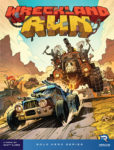 The age of solo boardgaming is among us. With the business of everyday life, there will always be boardgamers who simply can’t get free on a regular basis to play with their friends. For years, one’s only option was to take a boardgame and play against oneself. With the rise of cooperative games, it was possible to take on a game without having to be your own enemy. Unsurprisingly, solo boardgaming received a big bump during the pandemic. While digital implementations of boardgames are available, sometimes it is nice to lay everything out on the table and play the game with easy access to the entire game state at once. Wreckland Run is a recent solo boardgame entry by Scott Almes (designer of another good solo game, Warp’s Edge.) Wreckland Run has you driving your armed-to-the-teeth, tricked-out car through a post-apocalyptic gauntlet of enemy vehicles. If you manage to drive and shoot your way successfully to the end, another six adventures await.
The age of solo boardgaming is among us. With the business of everyday life, there will always be boardgamers who simply can’t get free on a regular basis to play with their friends. For years, one’s only option was to take a boardgame and play against oneself. With the rise of cooperative games, it was possible to take on a game without having to be your own enemy. Unsurprisingly, solo boardgaming received a big bump during the pandemic. While digital implementations of boardgames are available, sometimes it is nice to lay everything out on the table and play the game with easy access to the entire game state at once. Wreckland Run is a recent solo boardgame entry by Scott Almes (designer of another good solo game, Warp’s Edge.) Wreckland Run has you driving your armed-to-the-teeth, tricked-out car through a post-apocalyptic gauntlet of enemy vehicles. If you manage to drive and shoot your way successfully to the end, another six adventures await.
Wreckland Run
Publisher: Renegade Game Studios
Designer: Scott Almes
Ages: 10+
Players: 1
Time: 30-45 mins
(Review copy provided by publisher)
The heart of the game involves rolling a set of dice and using them to take actions. First, players roll and use the dice to equip their car. Then, a series of dice rolls are used to defeat a wave of enemy cars. Next, a new round of equipment purchasing and repair occurs (with associated die rolls) followed by another wave of enemies. Eventually, a wave of enemies will include the “boss car” of the scenario. Defeat the boss without blowing up to win the game. Each scenario may include special equipment, enemy cars, and possibly special rules. Defeat the boss of each chapter to win the campaign game.
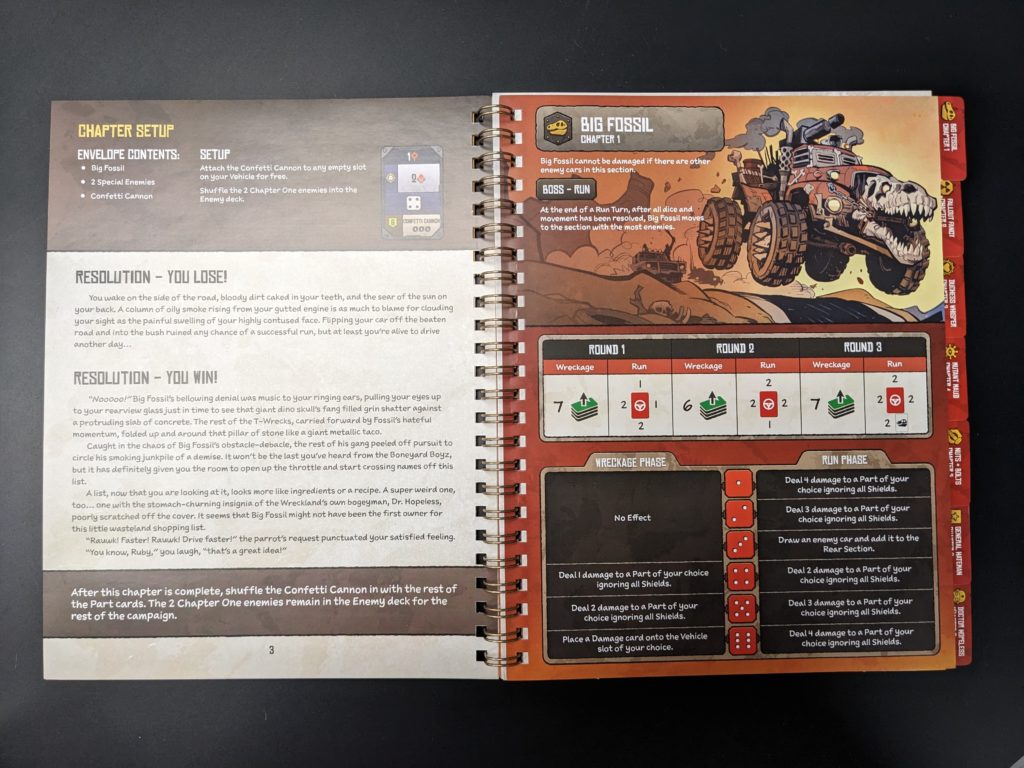
To start a game, pick a car and a driver (there are several of each available – cars have some unique equipment while drivers give a unique ability) and then choose a scenario. Typically a player chooses the first of six linked adventures, but they can also be played individually. Based on the scenario, a deck of opponent cars is constructed. This stack will be fought several times, with a mini-boss car added in the last round of an adventure. Each adventure begins with a purchase/improvement phase where players use their dice pool to purchase upgrades and new equipment for their vehicle off of a tableau of cards. Some scenarios even give the player extra equipment for free.
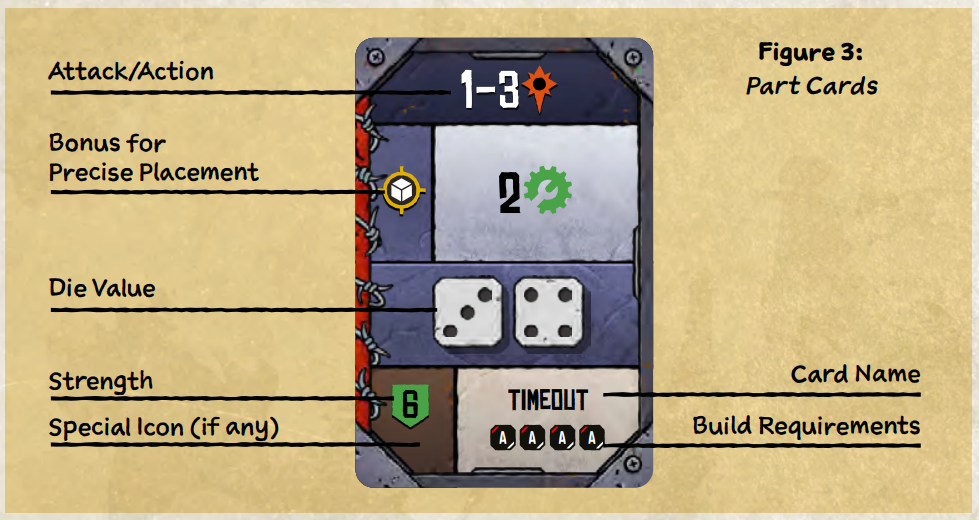
For the equipment purchasing phase, lay out a tableau of possible purchases and then roll all eight dice. “Spend” the dice to purchase equipment – each card has a listed dice requirement that must be spent. By removing possible purchases from the tableau, It is possible to reroll any or all unused dice. There are five white and three red dice. The red ones typically mean something bad. During the purchase phase, when a red die is used in a purchase it is immediately rerolled and compared to a chart for that scenario’s boss. This can result in no effect or something particularly bad (like damaging the core of your vehicle.) Players have a small pile of “scrap” at the start of the game (which are simply cars drawn from the enemy deck.) Scrap cards can be used at most points in the game as a die of the value shown on the face of the card. Each car comes with a few special starting abilities/weapons specific to that make and model. These special ones can also be upgraded later in the game. After purchasing, bits of equipment are slotted into the car.
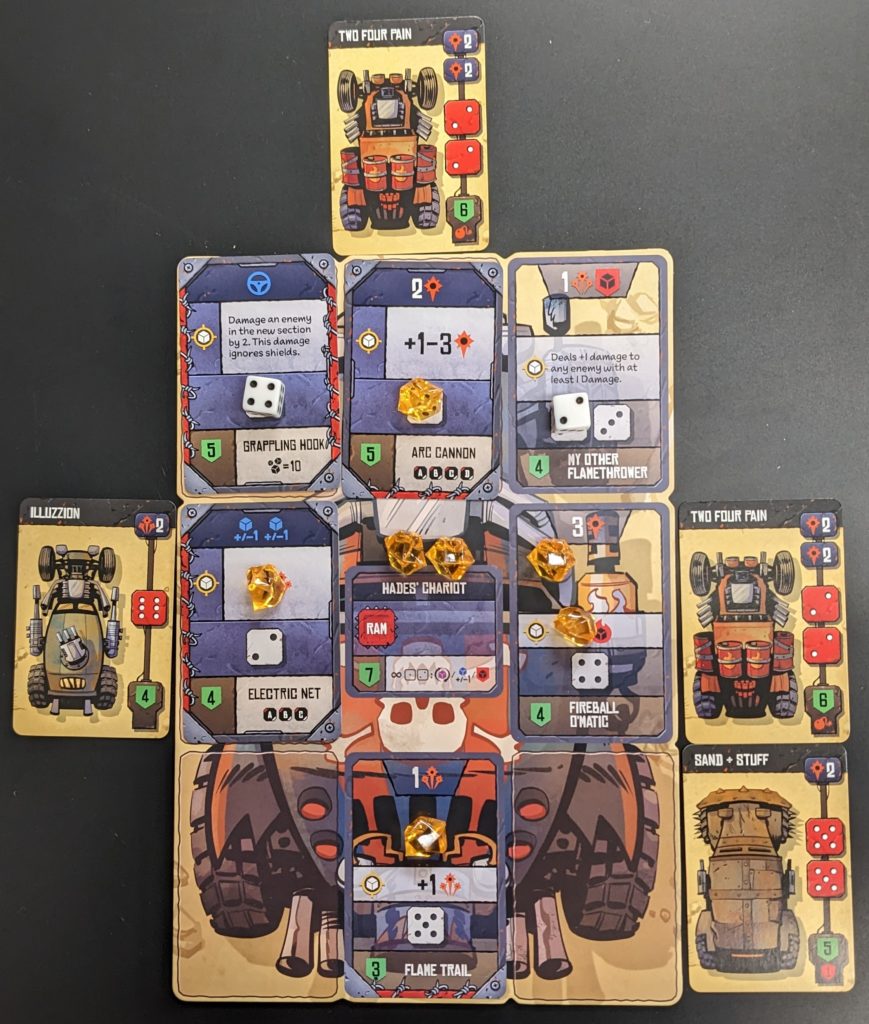
Every vehicle consists of a 3×3 grid. The outside 8 locations are used to slot in cards to serve as weapons while the inner location represents the car’s core and tracks damage and other basic car abilities. Purchased equipment can fill an empty slot or replace current equipment (damaged or not – as long as the equipment is not entirely destroyed.) Slots with destroyed equipment must be repaired before new equipment can be slotted in. After the purchasing phase, gameplay progresses to combat.
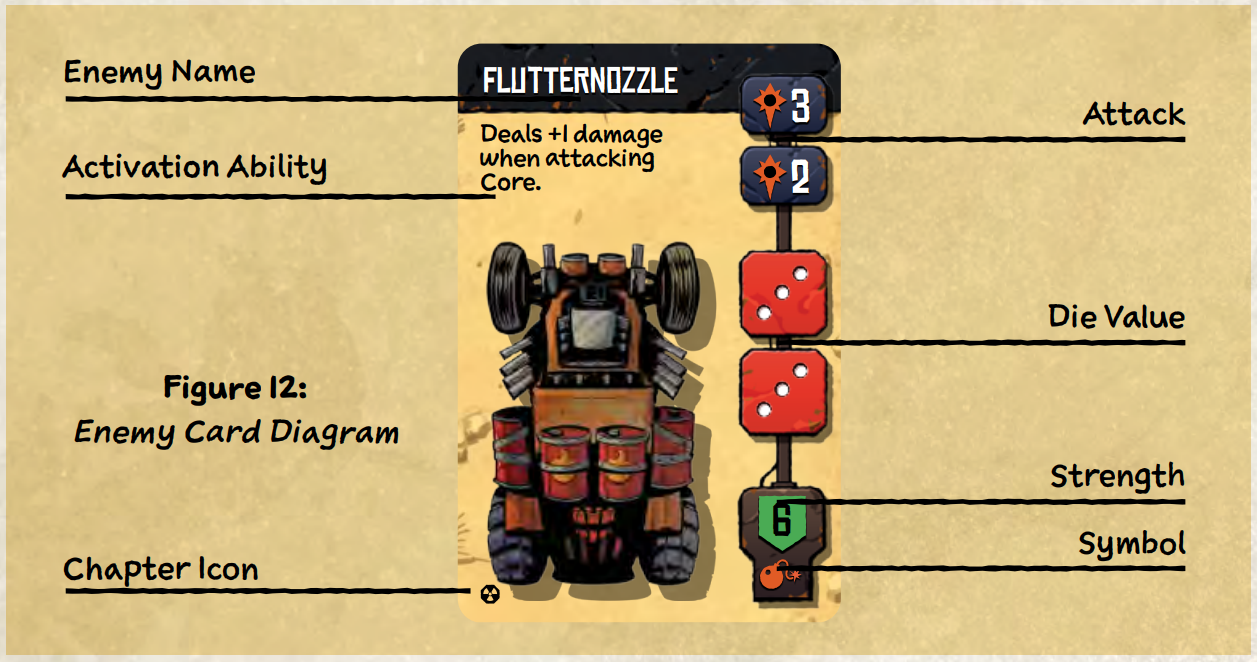
At the start of combat, enemy vehicle cards are placed next to a player’s car as shown in the scenario rules – how many cars and on which sides. Next, all the dice are rolled. First, one of the red dice is placed on a car with a matching die symbol. If none of the red dice match a car, roll on the boss table to see what bad effect will happen. Every car displaying the same number is then activated and will (typically) attack. Activated cars are then moved one side clockwise. Next, up to three white dice can be placed onto cards to activate them. Each slot can only hold one die. Scrap cards can also be used in combat to activate any equipment with a matching empty die slot. (This does not “fill” in the slot so a die can be placed there again later.) All the unused dice are then rerolled and the process is repeated (place a red die on an enemy, then place up to three white dice) until all the dice are used up. Activating an enemy car or weapon will typically do damage. The player gets to choose which car/equipment takes damage on the side of the attack. Enemy cards and equipment have a maximum health – if they take that much damage they are out of commission (removed in the case of enemy cars, destroyed in the case of a player’s equipment.) Some equipment and cars have a shield value, this is subtracted from any damage before it is applied. If damage to one’s car does not have a valid target, the damage proceeds into the core of the car, if the car’s health is reduced to zero, the car blows up, the run is a loss and must be restarted from the beginning. However, when there are two or fewer enemy cars remaining, the round ends and goes into a new round of purchasing and repair.
Damaged equipment, but not core health, can be repaired. Dice that exceed the equipment’s die value repair it completely, dice that exactly match will completely repair it. Alternatively, a damaged part can be simply replaced with a newly purchased one. Destroyed parts have special requirements to fix the slot and these must be met before a new purchase can be slotted there. Note, it is possible to repair equipment during the combat phase, but repairs are less effective (healing 1 or 2 points depending on die value.) After the purchase/repair round is completed, enemy cards are placed around the vehicle and a new round of combat begins. The introductory scenario has two rounds of combat, with a third round that includes the boss car. Defeat the boss car to win the entire scenario and progress to the next mission in the campaign.
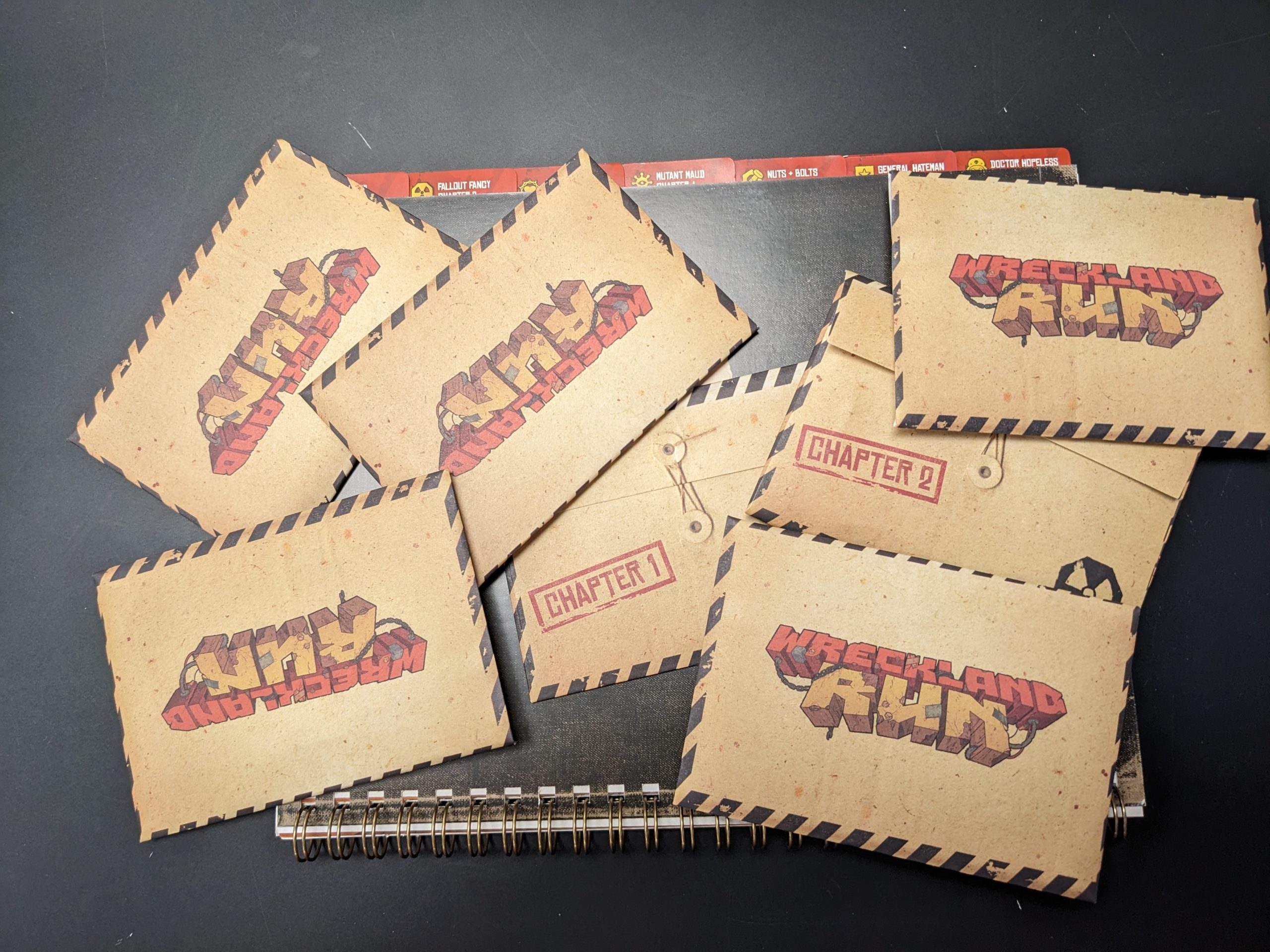
Several things of note. Every car has special abilities in their core. Several require a die roll of 1 or 2 to activate (like save a die for next round, reroll an unspent die, or empty a filled equipment spot.) The Ram ability can be activated with any die roll. Equipment cards may have barbed wire on one or more borders. To ram, a die is spent and then a side of the player’s choice will damage the adjacent cards based on the number of equipment cards with exposed barbed wire. Thus there is a maximum of three and minimum of zero damage. Then, each car on that side (damaged or not) is moved to an adjacent side of the player’s choice. There is no slot for dice on the ram action so it can be repeated if a player desires.
Verdict:
I found the theme of the game to be enjoyable and it is well supported by the backstory, equipment cards, and enemy vehicles (particularly the scenario bosses.) Managing dice is a tough balancing act, and one learns to really hate those red dice. Several resources must be simultaneously managed. Dice to be placed (red and white), open locations to play those dice, when to repair vs attack, when to spend those precious Scrap cards, etc… There is almost always some reroll coming up and it needs to be decided whether to use a die now, or hope for a better value later (but it could be worse!) Attacking cars move around the vehicle so even a ram action with zero damage can be important in order to maneuver an enemy car into the sights of a particularly nice weapon. This all combines into a thinky little puzzle that may need to be changed on the fly as rerolls start to mess up one’s plans.
The game has a difficulty adjustment, primarily by giving a player more or fewer Scrap cards at the start of the game. There is definitely some skill involved, as my first game (even at the lowest difficulty level) eliminated me even before I cleared the first wave of cards – much less met up with the boss. (If you must know, I had two enemy cars with shields. I had bought some area-effect weapons, but nothing with big damage so I couldn’t punch through those shields.) On my second attempt, I made it to the final boss before being overwhelmed by the addition of more enemy cars faster than I could kill them. Simply chucking one’s dice into whatever weapon is most convenient is not enough. Balancing repair with offense and balancing Scrap use in and out of combat is important to make it through to the end.
Do I like the game? Yes. The post-apocalyptic vehicle theme is great – reminding me of time spent playing Car Wars in my youth. Throw on the soundtrack (or even movie) of Mad Max in the background just to set the mood. I’m still in the high-maintenance parenting phase so there aren’t a lot of nights out for gaming. The majority of my solo gaming uses digital implementations of boardgames but a physical game has several advantages. Digital implementations rarely let you see the entire field of information in one go, so taking in game-state data (so often so important in solo games) is more difficult. Rolling physical dice is also more fun.
Components-wise, I have no complaints. Everything I want to be sturdy is pretty sturdy and everything fits snugly in the box without wasting too much space. The game layout does take up enough space that I can’t play it on my lap or in the car/airplane, but not so much that I couldn’t cram it onto an end table.
There is a sequel, Wreckland Run: Fallout, that has three new campaign chapters, toxic and missile type weapons, and a few new player cars, drivers, and upgrades. It’s a nice addition to the game, but not necessary until one has run the main game enough times to want new challenges and/or variety.
Kid Factor: A bit of a strange bird here. As a solo game, there isn’t a chance for an adult to help out with play issues, however it isn’t all that deep. I’d expect it would go over well with the pre-teen crowd on upward, with the theme as a possible additional attraction. Violence-wise everything is pretty abstracted, with cars and things blowing up and no mention or concern about who or what is inside them.





Discussion Area - Leave a Comment